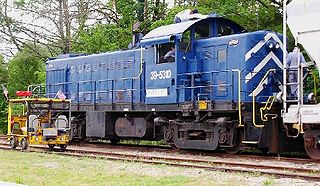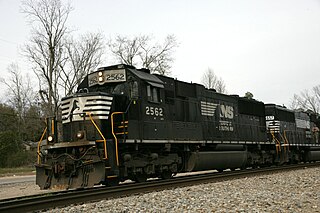
Montreal Locomotive Works (MLW) was a Canadian railway locomotive manufacturer that existed under several names from 1883 to 1985, producing both steam and diesel locomotives. For many years it was a subsidiary of the American Locomotive Company. MLW's headquarters and manufacturing facilities were in Montreal, Quebec.

The EMD DDA40X is a 6,600 hp (4,943 kW) D-D locomotive, built by EMD from 1969 to 1971 exclusively for the Union Pacific Railroad. It is the most powerful diesel-electric locomotive model ever built on a single frame, having two 16-645E3A diesel prime movers. Union Pacific has marked DD40X on the cab exteriors, while EMD literature inconsistently refers to this model as either DD-40X or DDA40X.

A hood unit, in North American railroad terminology, is a body style for diesel and electric locomotives where the body is less than full-width for most of its length and walkways are on the outside. In contrast, a cab unit has a full-width carbody for the length of the locomotive and walkways inside. A hood unit has sufficient visibility to be operated in both directions from a single cab. Also, the locomotive frame is the main load-bearing member, allowing the hood to be non-structural and easily opened or even removed for maintenance.

A road switcher locomotive is a type of railroad locomotive designed to both haul railcars in mainline service and shunt them in railroad yards. Both type and term are North American in origin, although similar types have been used elsewhere.

The EMD SD70 is a series of diesel-electric locomotives produced by the US company Electro-Motive Diesel. This locomotive family is an extension and improvisation to the EMD SD60 series. Production commenced in late 1992 and since then over 5,700 units have been produced; most of these are the SD70M, SD70MAC, and SD70ACe models. While the majority of the production was ordered for use in North America, various models of the series have been used worldwide. All locomotives of this series are hood units with C-C trucks, except the SD70ACe-P4 and SD70MACH which have a B1-1B wheel configuration, and the SD70ACe-BB, which has a B+B-B+B wheel arrangement.

The EMD SD90MAC is a model of 6,000 hp (4,470 kW) C-C diesel-electric locomotive produced by General Motors Electro-Motive Division (EMD). It is, with the SD80MAC, one of the largest single-engined locomotives produced by EMD and among the most powerful diesel-electric locomotives, surpassed only by the dual-engined DDA40X.

The EMD SD40-2 is a 3,000-horsepower (2,200 kW) C-C diesel-electric locomotive built by EMD from 1972 to 1989.

The EMD Dash 2 is a line of diesel-electric locomotives introduced by General Motors' Electro-Motive Division (EMD) on January 1, 1972. Designations of these models were those of the former models with "-2" added. They retained the basic specifications of the earlier models in terms of power output and most other features, but introduced a number of improvements to the locomotives' internal systems, specifically the electrical systems and the trucks of the locomotives. These were intended to improve availability, efficiency, and ease of maintenance.

The EMD SD60 is a 3,800 horsepower (2,800 kW), six-axle diesel-electric locomotive built by General Motors Electro-Motive Division, intended for heavy-duty drag freight or medium-speed freight service. It was introduced in 1984, and production ran until 1995.
On February 8, 1986, twenty-three people were killed in a collision between a Canadian National Railway freight train and a Via Rail passenger train called the Super Continental, including the engine crews of both trains. It was the deadliest rail disaster in Canada since the Dugald accident of 1947, which had thirty-one fatalities, and was not surpassed until the Lac-Mégantic rail disaster in 2013, which resulted in 47 deaths.

The EMD GP38-2 is an American four-axle diesel-electric locomotive built by General Motors, Electro-Motive Division. Part of the EMD Dash 2 line, the GP38-2 was an upgraded version of the earlier GP38. Power is provided by an EMD 645E 16-cylinder engine, which generates 2,000 horsepower.

The EMD GP40-2 is a 4-axle diesel-electric locomotive built by General Motors Electro-Motive Division as part of its Dash 2 line between April 1972 and December 1986. The locomotive's power is provided by an EMD 645E3 16-cylinder engine which generates 3,000 horsepower (2.24 MW).

An SDP40 is a 6-axle passenger diesel-electric locomotive built by General Motors Electro-Motive Division (EMD) between June 1966 and May 1970.

The SD39 is a model of 6-axle diesel-electric locomotive built by General Motors Electro-Motive Division between August 1968 and May 1970. 54 were built for American railroads.

In railroading, a slug is a version of a diesel-electric locomotive which lacks a prime mover, and often a cab. It derives the electrical power needed to operate its traction motors and motor controls from a fully-powered mother locomotive. When coupled together it takes advantage of the excess current that the mother's diesel-electric locomotive produces at low speed, providing additional horsepower and braking at such operation without the expense of a full locomotive.

The Goderich–Exeter Railway is a short line freight railway that operates around 70 miles (110 km) of track in Southwestern Ontario, Canada. Created in 1992, it was the first short line railway in Canada to be purchased from a class I railway, in this case Canadian National Railway (CN). It took over operation of further CN trackage in 1998. As of 2004, the railway had 44 employees. Its headquarters are in Stratford, Ontario, and owned by short-line railroad holding company Genesee & Wyoming.

The long hood of a hood unit-style diesel locomotive is, as the name implies, the longer of the two hoods on a locomotive, particularly American-type freight locomotives.

The MLW M-420 was a diesel-electric locomotive manufactured between 1973 and 1977 in Montreal, Canada by the Montreal Locomotive Works. A total of 88 units were built for Canadian railways, including eight B units built for the British Columbia Railway; most of production went to Canadian National. Only seven units were sold outside of Canada, to the State Railways Institution in Venezuela and the Providence and Worcester Railroad in the United States.

The EMD SD30C-ECO is a 3,000-horsepower (2,200 kW) C-C diesel-electric locomotive built by EMD. Although similar to the EMD SD32ECO, the SD30C-ECO follows the Canadian Pacific Railway's request for crashworthiness and EPA emission standards with the "C" in the designation denoting crashworthiness of the cab, frame, and fuel tank. CP rail requested relaxed emission standards to cut costs.




















